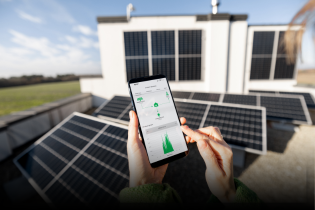In today’s world of escalating energy demands and growing environmental concerns, Energy Management Systems (EMS) are emerging as critical tools for businesses and individuals alike. With global electricity consumption reaching unprecedented levels, the need for efficient energy management has never been greater. This article delves into the intricacies of EMS, exploring how these systems optimize energy consumption, drive cost savings, and promote a sustainable future.
What is an Energy Management System (EMS)?

An EMS is a sophisticated digital solution designed to monitor, control, and optimize energy usage across diverse applications, from industrial facilities to residential buildings. Leveraging technologies like IoT, advanced analytics, and automation, EMS acts as the “brain” of energy-saving strategies, providing valuable insights and actionable recommendations.
Key Components of an EMS
Energy Monitoring Tools: Sensors and meters that collect real-time energy consumption data.
Data Analytics Platform: Software that processes and analyzes collected data to identify patterns and trends.
Control Systems: Automated systems that implement energy-saving measures based on the analyzed data.
User Interface: Dashboards and reports that provide users with clear and actionable insights.
Why is Energy Management Crucial?
Energy management is not merely about reducing energy costs; it’s a critical step towards a sustainable future.
- Environmental Sustainability
Reduced Carbon Emissions: By optimizing energy consumption, EMS significantly reduces carbon emissions, mitigating the impact of climate change.
Facilitated Renewable Energy Integration: EMS enables seamless integration of renewable energy sources like solar and wind power, maximizing their utilization.
Long-term Conservation: Promotes the conservation of non-renewable resources for future generations.
- Cost Efficiency
Eliminating Waste: Identifies and eliminates energy inefficiencies, such as idle equipment or inefficient processes.
Optimizing Energy Tariffs: Analyzes energy consumption patterns and recommends cost-effective energy plans.
Maximizing Equipment Life: Predictive maintenance capabilities extend equipment lifespan and reduce maintenance costs.
- Regulatory Compliance
Ensures Compliance: Helps businesses comply with evolving energy efficiency regulations and standards.
Avoids Penalties: Minimizes the risk of fines associated with non-compliance.
- Energy Security and Reliability
Avoids Downtime: Predicts and prevents potential disruptions in energy supply.
Efficient Resource Allocation: Optimizes energy distribution to meet demand effectively.
- Enhanced Corporate Social Responsibility (CSR)
Enhances Brand Image: Demonstrates a commitment to sustainability, appealing to eco-conscious consumers and investors.
Boosts Employee Engagement: Fosters a culture of sustainability within the organization.
How IoT Powers Energy Management Systems?

The integration of IoT technology has revolutionized EMS, enabling real-time monitoring, predictive analytics, and advanced automation.
Real-Time Energy Monitoring: IoT sensors provide granular data on energy consumption across various points within a system, enabling real-time identification of inefficiencies.
Predictive Maintenance: AI-powered algorithms analyze real-time and historical data to predict potential equipment failures, minimizing downtime and reducing maintenance costs.
Remote Control and Automation: IoT enables remote control of energy systems, allowing for automated adjustments to HVAC systems, lighting, and other energy-intensive equipment.
Integration with Renewable Energy Sources: Facilitates seamless integration and optimization of renewable energy sources, such as solar and wind power.
Advanced Data Analytics and AI: AI algorithms analyze vast amounts of data to forecast energy demand, identify optimization strategies, and provide actionable insights.
Demand Response and Grid Interaction: Enables participation in demand response programs, optimizing energy consumption during peak demand periods.
Energy Auditing and Compliance: Provides comprehensive energy audits and facilitates regulatory compliance.
Benefits of Implementing an Energy Management System

Increased Energy Efficiency: Optimizes energy consumption across all areas of operation.
Significant Cost Savings: Reduces energy bills and minimizes operational expenses.
Improved Operational Performance: Enhances operational reliability and minimizes downtime.
Sustainability Goals Alignment: Aligns with sustainability goals, reducing environmental impact.
Enhanced Corporate Social Responsibility: Improves brand image and attracts eco-conscious consumers and investors.
Scalability and Adaptability: Adapts to changing business needs and evolving energy landscapes.
Regulatory Compliance: Ensures compliance with energy efficiency regulations and minimizes the risk of penalties.
Conclusion
In an era of increasing energy demands and growing environmental concerns, Energy Management Systems are no longer a luxury but a necessity. By optimizing energy consumption, reducing costs, and promoting sustainability, EMS empowers businesses and individuals to make informed decisions and build a more sustainable future.
Contact FSM Connect today to explore our innovative energy management solutions and discover how we can help you achieve your sustainability goals.


